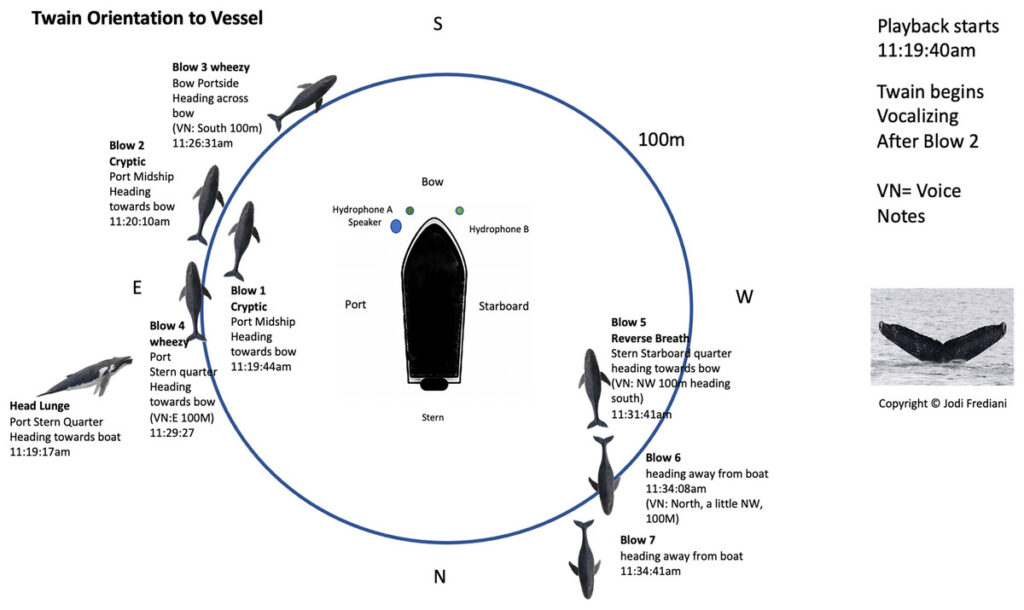Bridging Oceans and Outer Space: A New Era of Communication
- Scientists from Whale-SETI engaged in a groundbreaking 20-minute interaction with a humpback whale named Twain, using AI to decode whale communication.
- This encounter not only advances our understanding of marine life but also aids in the search for extraterrestrial intelligence by exploring nonhuman communication systems.
- The study highlights the potential of AI in bridging communication gaps between species and possibly with life beyond Earth.

In a remarkable encounter off the coast of Alaska, scientists from the Whale-SETI project experienced what they describe as a “conversation” with a humpback whale named Twain. This extraordinary event, led by Dr. Brenda McCowan from the University of California Davis, marks a significant milestone in the study of interspecies communication. The Whale-SETI team, dedicated to understanding whale communication systems, aims to apply these insights to the search for extraterrestrial life.
The encounter began with the team playing a recorded humpback “contact” call into the ocean using an underwater speaker. To their astonishment, Twain approached their boat and began responding, matching the intervals between each call they played. For about 20 minutes, Twain circled the researchers, engaging in what appeared to be a communicative exchange in the whale’s own “language.” Dr. McCowan expressed her excitement, noting that this might be the first such interaction between humans and humpback whales using the whales’ natural signals.
The science behind this encounter is rooted in the Whale-SETI team’s efforts to develop filters for detecting intelligent signals, which could be instrumental in the search for extraterrestrial intelligence. By studying whale communication, they hope to identify patterns that might also apply to signals from outer space. Dr. Fred Sharpe from the Alaska Whale Foundation emphasized the intelligence of humpback whales, highlighting their complex social systems and unique behaviors, such as creating bubble nets to catch fish and communicating through songs and social calls.
The behavior observed in Twain supports a crucial idea in the search for life beyond Earth. Dr. Laurance Doyle of the SETI Institute noted that the assumption that extraterrestrials would be interested in making contact is supported by the behavior of humpback whales. Engaging with whales could teach us how to detect and understand intelligent signals, whether from the ocean’s depths or the far reaches of space.
The researchers plan to use mathematics and AI, specifically information theory and machine learning, to measure the complexity of whale communication and understand the rules and structures in the messages they receive.
The Whale-SETI team is not stopping there. They are preparing another paper focusing on non-audio ways humpback whales might communicate, such as the bubble rings they create around humans. Co-authors Dr. Josie Hubbard, Lisa Walker, and Jodi Frediani bring expertise in animal intelligence, whale song analysis, and whale behavior to the project. The team acknowledges the financial support from the Templeton Foundation Diverse Intelligences Program, which made their research possible.
Whale-SETI, short for Whale Search for Extraterrestrial Intelligence, is a unique project that combines marine biology with the quest to find life beyond Earth. The researchers aim to decode whale communication, working under the idea that these sounds might contain complex messages similar to human languages or even those of extraterrestrial beings. Using advanced technology like sophisticated underwater microphones and AI, they record and analyze whale sounds, looking for patterns that might indicate language-like structures. This not only helps us understand whales better but also could improve how we search for intelligent life elsewhere.
Humpback whales, known scientifically as Megaptera novaeangliae, are fascinating creatures. They can grow up to 60 feet long and weigh as much as 40 tons. Recognized by their long pectoral fins and knobbly heads, these whales travel great distances, migrating up to 5,000 miles between feeding and breeding grounds. Their complex and melodious songs play a crucial role in social interactions, especially during the breeding season. Once hunted nearly to extinction, humpback whale populations have been recovering thanks to international protections. However, they still face threats like entanglement in fishing gear, ship collisions, and environmental changes due to climate change. Understanding their communication and social structures can aid in conservation efforts, ensuring these majestic creatures continue to thrive.
The SETI Institute, founded in 1984, is dedicated to exploring life beyond Earth. Using cutting-edge technology, their team of scientists scans the skies for radio signals and other potential indicators of extraterrestrial civilizations. Their main goal is to analyze data from space, hoping to uncover patterns or messages that could reveal we are not alone in the universe. The SETI Institute also inspires and educates the public through workshops, lectures, and interactive programs designed to spark curiosity and nurture the next generation of scientists. Their work with Whale-SETI represents an exciting intersection of this quest and the study of intelligent life on our planet.
The encounter with Twain is not just a fascinating story about humans and a whale. It is a step toward understanding intelligence in all its forms. By learning how to communicate with humpback whales, scientists hope to develop tools that could one day help us recognize and understand messages from extraterrestrial beings. This research highlights the importance of examining the intelligent life we share our planet with, suggesting that by understanding the minds of whales, we can better prepare ourselves for encounters with life beyond Earth.
